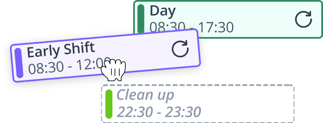In this article, we look closer at the concept of on-call scheduling, its applicability across industries, and the intricacies of setting it up effectively.
What is an on-call schedule?
An on-call schedule is a type of work rota where employees aren't necessarily at work, but they're ready to step in if needed. Think of it like being a goalkeeper on the bench—you're not always in the game, but you're ready to jump in quickly if your team needs you.
In practice, this means:
- Employees are reachable during specific hours.
- They can be called to work at short notice.
- They're often paid extra for being available.
Common jobs with on-call schedules
Some roles just can't function without on-call rotas:
- Doctors and nurses
- IT technicians (someone has to fix that pesky server at 2 am!)
- Plumbers and electricians (burst pipes wait for no one!)
- Customer support teams
Types of on-call schedules
Not all on-call shifts are created equal. Depending on your industry, your team setup, and your legal obligations, you might need different types of on-call rotas. Here’s a breakdown to help you figure out what’s what—and what works best for your business.
📞 Standby/on-call from home
The employee isn’t at work, but they need to be reachable and ready to come in (or log in) if something goes wrong.
Example: An IT engineer who’s at home but can jump online to fix a server issue.
Good for:
- IT support
- Facilities maintenance
- Emergency trades (e.g. plumbers)
Things to keep in mind:
- Some countries (like the UK) might not count this as “working time” unless the employee is actually called in.
- Still, you may need to offer an on-call allowance as a thank-you for their availability.
🚨 Immediate-response on-call
This is more intense. The employee needs to be within a certain distance from the workplace and ready to work immediately if needed.
Example: A doctor who must stay within 15 minutes of the hospital during their on-call shift.
Good for:
- Healthcare
- Emergency response
- Security staff
Key point: Because this setup heavily restricts personal time, it’s often treated as working time and should be paid accordingly—especially in the UK and EU.
📅 Rotating on-call schedule
The responsibility for being on-call is shared across a team on a regular cycle (daily, weekly, monthly, etc.).
Example: Each member of a tech support team takes turns being on-call for a week at a time.
Good for:
- Spreading the load fairly
- Keeping burnout low
- Larger teams with shared responsibilities
Top tip: Use a rota planner or scheduling tool (like Shiftbase) to rotate shifts fairly and transparently.
🧑🤝🧑 Secondary or backup on-call
Here, you’ve got a primary person on-call, but also a backup in case they’re unavailable.
Example:
A primary IT tech gets the first call, but if they don’t respond in 10 minutes, the backup tech is alerted.
Great for:
- Critical operations
- Ensuring no calls go unanswered
- Reducing pressure on a single employee
There’s no one-size-fits-all when it comes to being on-call. Some employees are glued to their phone at home, others need to be ready to rush in like superheroes. This handy table breaks down the key differences between each type—so you can pick the one that makes sense for your business (and keeps your team sane).
| Type of on-call | Where they are | Response time | Is it working time? | Best for |
|---|---|---|---|---|
| Standby at home | At home | Within reason | Sometimes | IT, trades |
| Immediate-response | Nearby | ASAP | Usually yes | Healthcare, security |
| Rotating schedule | Varies | Depends | Depends | Larger teams |
| Backup/secondary | Varies | If needed | Only if called | High-priority roles |
How to choose the right on-call setup for your team
Not sure which on-call setup fits your team best? No worries—this bit will help you figure it out based on what your business needs, how your team works, and what the law says you must (or mustn’t) do.
What kind of work is it?
Start with the nature of the job. Is it critical that someone jumps in immediately when something goes wrong? Or can it wait a bit?
- Urgent services (like healthcare, security, or emergency repairs) usually need a tighter, more reactive setup—think immediate-response or secondary on-call.
- Non-urgent issues (like general IT support or admin help) may be fine with a standby-from-home or rotating schedule.
How big is your team?
The size of your team can make or break an on-call system.
- Small team? A fixed schedule or simple standby might be enough. But make sure it’s fair—nobody wants to be “the on-call person” forever.
- Bigger team? Rotate shifts! A rotating on-call setup spreads responsibility and helps prevent burnout.
➡️ Top tip: Use shared calendars or a scheduling tool to keep everyone in the loop.
What does the law say?
This one’s important. Your setup has to follow local labour laws:
-
UK: If the employee is restricted (e.g. must stay close to work), it may count as working time, even if they’re not actually working. This can affect how many hours they’re legally allowed to work.
-
US: Rules vary by state. For example, California often requires compensation if an employee’s personal time is heavily restricted, even if they’re not actively working.
👉 Always check the law before assigning on-call shifts. If in doubt, get legal advice or speak to your HR software provider.
What’s best for employee wellbeing?
Sure, coverage matters—but so does morale. On-call work can be stressful, especially if expectations are unclear.
- Be realistic about how often people will be called
- Offer on-call pay or perks (like time off in lieu)
- Let people switch or swap shifts if needed
Legal considerations and compliance
On-call work can get tricky if you're not up to speed with local labour laws. What counts as working time? Do you have to pay them even if they’re not called in? Let’s break it down before any legal headaches show up.
🇬🇧 UK on-call rules: what employers need to know
In the UK, on-call time can count as working time, depending on the level of restriction placed on the employee. It’s all guided by the Working Time Regulations 1998 and some newer updates.
✅ When on-call is working time:
- The employee has to stay on work premises.
- Or they must stay within a fixed distance and respond immediately.
- Or their personal time is significantly limited (e.g. no alcohol, no travel).
In these cases, you need to:
- Count the hours towards their weekly working limit (48 hours max unless opted out).
- Pay the National Minimum Wage or more.
- Make sure they get their legal rest breaks and daily/weekly rest.
🚫 When on-call is not working time:
-
If the employee can do whatever they want during that time (within reason) and is only called occasionally.
-
For example, they’re at home and only need to be reachable.
📢 New developments to keep an eye on:
-
Employment Rights Bill (2024–2025): Still under review, but could affect how on-call time is managed—especially regarding notice periods and flexibility.
-
Right to Disconnect: Although not legally enforced in the UK (yet), it’s becoming a hot topic. Employers may be expected to show they respect workers' boundaries.
🇺🇸 US on-call laws: depends on the state (of course)
In the US, it’s a little more “it depends” (as usual). The Fair Labor Standards Act (FLSA) provides the federal rules, but state laws can be stricter.
🧾 When on-call time must be paid:
- If the employee is required to stay at the workplace.
- If they must stay close enough to restrict their personal time significantly.
- If the response time is super tight.
📍 Example:
In California, if an employee has to respond quickly and can’t freely use their time, you’ll likely owe them compensation—even if they’re never called.
✋ When it doesn’t need to be paid:
-
The employee is at home and free to use their time how they like.
-
They only respond occasionally and have a flexible response window.
What to do:
-
Check both federal and state laws.
-
Be consistent in how you classify and pay on-call time.
-
Document expectations clearly in employment contracts or handbooks.
On-call pay and allowances
Money talks—and when it comes to being on-call, your team will want to know exactly how (and when) they’re getting paid. Let’s clear it up.
Do you always have to pay for on-call time?
Short answer: Not always.
Longer answer: It depends on what the employee can or can’t do while they’re on-call. Here's the lowdown:
| Situation | Do you have to pay? | Why? |
|---|---|---|
| Employee must stay on-site or respond immediately | ✅ Yes | It’s “working time” |
| Employee is at home but must be reachable | ❌ Maybe not | Only pay if they’re actually called in (depends on the law) |
| Employee is called in during on-call hours | ✅ Yes | This is actual working time |
🇬🇧 UK rules
-
If it counts as working time, you must pay at least the National Minimum Wage.
-
Many employers offer a flat on-call allowance for availability, plus hourly pay if they’re called in.
-
No set law on how much the allowance must be—it’s up to you (but be fair!).
🇺🇸 US rules
-
FLSA (Federal): Only need to pay if time is “restricted” or if they’re actively working.
-
State laws vary: California, New York, and a few others have stricter rules.
-
Pay could be:
-
A fixed rate for on-call time
-
Hourly pay if called in
-
Overtime if total weekly hours go over the legal limit
-
Good practices
-
Pay something for availability—it shows respect.
-
Be transparent about pay in contracts and handbooks.
-
Use software to track call-ins so you’re not guessing.
Common on-call scheduling mistakes to avoid
Getting on-call wrong can hurt morale, cause burnout—or land you in legal hot water. Here’s what to steer clear of:
❌ Not paying fairly: Assuming on-call time doesn’t count as work can backfire—especially if your team feels exploited or local laws disagree with you.
❌ Always calling the same person: It’s easy to rely on your most dependable employee, but if they’re always the one on-call, they’ll burn out. Fast.
❌ No clear expectations: If your team doesn’t know when they’re on-call, how quickly they need to respond, or what’s expected—it leads to chaos. And complaints.
❌ No documentation: Verbal agreements won’t cut it. Without a written policy, disputes over pay or hours can get messy.
❌ Ignoring rest breaks: Even on-call employees need rest time. Make sure your scheduling respects legal daily and weekly limits.
How to create a fair on-call schedule policy
A clear, fair on-call policy keeps everyone happy—and out of tribunal court. Here’s how to build one that works:
What to include in your on-call policy
-
Who can be scheduled on-call (roles, departments)
-
How on-call shifts are assigned (rotation, voluntary, etc.)
-
Response expectations (how fast, where they need to be)
-
How on-call time is compensated (flat rate? hourly? both?)
-
How to report issues (missed calls, disputes, fatigue)
Communicate clearly
-
Add the policy to your staff handbook.
-
Go over it in onboarding and team meetings.
-
Make it easy to find and understand (no legalese, please).
Stay flexible
Let employees swap shifts, opt out for personal reasons, or raise concerns. The more human your approach, the less drama later on.
Review regularly
Laws change. Business needs shift. Your policy should keep up. Aim for a yearly review—earlier if your staff raise issues.
💡 Bonus idea:
Offer a one-pager or downloadable guide called “Your On-Call Rights & Responsibilities” for staff—keeps things clear and avoids surprises.
How Shiftbase makes on-call scheduling easier (and smarter)
Juggling on-call shifts with spreadsheets or group chats is a headache waiting to happen. With Shiftbase, you can ditch the chaos and manage your team’s availability, call-out rotas, and legal compliance all in one smart platform.
Here’s how Shiftbase helps:
-
📅 Build and adjust employee schedules in seconds, including on-call shifts, rotations, and backups.
-
⏱️ Automatically track hours with time tracking, so you know exactly when someone’s been called in (and how long they worked).
-
🚫 Manage leave, sickness, and time off with built-in absence management—so you don’t schedule someone who’s unavailable.
No more guesswork. No more rota mix-ups. Just smoother, stress-free scheduling with a tool that works the way you do.
👉 Want to see it in action?
Start your free 14-day trial today and see how Shiftbase makes on-call scheduling simple and efficient: Try Shiftbase for free 🚀

- Create rosters quickly
- Insight into labor costs
- Access anywhere via the app



